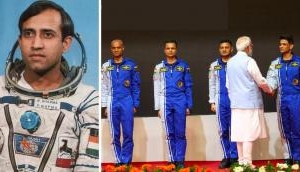Touch is the sense we understand the least - but maybe not for much longer

What tells you your bladder is full? Your body uses a sense that is so all-pervasive it's normally kept at a subconscious level so we aren't overwhelmed with information. Sometimes referred to as a sixth sense, this internal sensing ability is actually part of the "mechanical sense" that includes touch. It tells you where your legs are and whether they are safely touching the ground; that your shoulders are connected to your arms, and so on.
It relies on a network of nerve endings that constantly monitor our hair, skin, guts, bladder, joints, muscles, arms, legs and blood pressure. Have you ever woken unable to feel your arm? This is because reduced blood supply has sent the nerve endings to "sleep". You can move it - but you can't control it. When "feeling" returns, you slowly realise the arm is actually yours again. In rare cases, people can lose the sensation in much of their body permanently. If it affects the legs, they usually end up in a wheelchair. They can "will" their legs to move normally, but do not "know" if they are moving, so cannot rely on them to keep upright.
Yet despite the fundamental importance of our internal and external sense of touch, we don't understand how it works very well. If we did there could be major health benefits on the internal side - and not only for people who have lost sensation. For instance high blood pressure - an increasing problem as medical advances help us live longer - is the leading cause of stroke, cardiovascular disease and kidney failure. If we better understood the nerve endings that regulate blood pressure, we could potentially treat sufferers with drugs that were more effective at reducing it than the current selection.
Diabetes, which is also burgeoning, often leads to amputations as clogged blood vessels kill nerve endings sensitive to pain and touch. Limb injuries then go unnoticed and injuries from falls increase. It might be that clumsiness from dying muscle stretch receptors is an early diabetic indicator. Early movement tests during diagnostic assessments could allow more therapeutic intervention. There might also be the potential to alleviate painful muscle spasm after spinal-cord injury and spasticity in cerebral palsy.
Protein problems
The body's senses work thanks to different "detector proteins". What holds us back from understanding our mechanical sense is we don't know which proteins in the nerve endings detect movement or indeed how they do it.
The first problem is knowing where to find enough of the proteins in question. If you compare our vision, it is obvious where to collect the light-detector proteins that enable us to see. We see with the eyes and nothing else. It's a similar story for taste and smell (hearing is more complicated, and actually falls into the same category of mechanical senses, but that's for another day).
We do not have a special organ solely dedicated to touch; the nerves sensitive to movement are so important they are everywhere. They are usually very small; detect different textures such as light touch, heavy touch, vibration and sustained pressure; and intermix with endings for other senses such as temperature and pain. This makes them very difficult to isolate and study - not to mention ascertaining what type of "touch" they detect and whether they have other functions elsewhere in the body.
The picture is sufficiently complex that some wonder if we may have found too many such proteins - a view we would share. This has made scientists realise the importance of being very specific about which detector protein they are interested in and what it might detect.
Even then, research may have been held back by not carrying out enough tests. Different tests demonstrate different things, as we have shown in our new paper on the protein ASIC3 (Acid Sensitive Ion Channel 3). ASIC3 is found in the stretch-sensitive nerve endings in the muscles that tell us where our arms and legs are. Until now ASIC3's importance in detecting movement has been unclear, and scientists have even doubted whether it had any role at all.
We tested ASIC3 in three ways - in a cell culture, in isolated tissue and then in the body as a whole. In each case we tested some subjects with the protein turned on and some with it turned off to see how they behaved. When we tested it in a cell culture, we found that nerve endings with ASIC3 turned off could not detect very gentle movements. In isolated muscle tissue, we found the tissue actually over-responded to movement when it lacked ASIC3. And when we repeated the test in whole mice, we found that mice without the protein in their muscle-sensory endings were clumsier. Though results like these can throw up contradictions, we were able to conclude that ASIC3 seems most important for very fine motor control.
Where next?
Using combined tests in this way should make a big difference to testing the roles of proteins in mechanical sensation. But there are also other things we need to take into account in future. Scientists know the same nerve endings in muscle tissues can detect a variety of stimuli to do with stretching and squeezing. This could mean endings need a set of proteins, each detecting a different aspect of movement.
The fundamental importance of mechanical senses might also mean there is built-in redundancy. This would mean that losing one protein by mutation is not disastrous because another simply takes over. This might be why nerve endings in muscle actually have several related ASIC proteins, for instance.
But the good news is that this area is making progress - not just through our results but through various laboratories around the world. Our knowledge of touch is catching up with that of our other senses, and not before time.
![]()
Guy Bewick, Senior Lecturer, Biomedical Sciences, University of Aberdeen; Chih-Cheng Chen, Associate Research Fellow, Institute of Biomedical Sciences, Academia Sinica, and Robert Banks, Visitor in the School of Biological and Biomedical Sciences, Durham University
This article was originally published on The Conversation. Read the original article.
![]()






![BJP's Kapil Mishra recreates Shankar Mahadevan’s ‘Breathless’ song to highlight Delhi pollution [WATCH] BJP's Kapil Mishra recreates Shankar Mahadevan’s ‘Breathless’ song to highlight Delhi pollution [WATCH]](http://images.catchnews.com/upload/2022/11/03/kapil-mishra_240884_300x172.png)

![Anupam Kher shares pictures of his toned body on 67th birthday [MUST SEE] Anupam Kher shares pictures of his toned body on 67th birthday [MUST SEE]](http://images.catchnews.com/upload/2022/03/07/Anupam_kher_231145_300x172.jpg)






